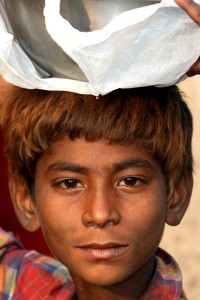 Chennai, 10th June, 2015: Kanna, a boy of 12 hailing from Rajahmundry, thought child labour was just natural, as many of his close friends were working. After dropping out of school in grade 7, he worked as a blacksmith and as an assistant for an automobile mechanic. While working at the blacksmith’s shop, he had to hammer away at big metal objects, like shock absorbers of large trucks. He once had his fingers crushed and split when the hammer landed on them instead of the metal pieces he held in them.
Chennai, 10th June, 2015: Kanna, a boy of 12 hailing from Rajahmundry, thought child labour was just natural, as many of his close friends were working. After dropping out of school in grade 7, he worked as a blacksmith and as an assistant for an automobile mechanic. While working at the blacksmith’s shop, he had to hammer away at big metal objects, like shock absorbers of large trucks. He once had his fingers crushed and split when the hammer landed on them instead of the metal pieces he held in them.
Kanna was rescued and rehabilitated following World Vision India’s intervention, like many others from across the country. In a country that adopts a lenient approach towards putting an end to child labour, it becomes tough to combat both the policy-level and ground-level obstacles which effectively promote the practice. The fact remains that child labour in any form, in any age below 18, is hazardous to children on many levels.
Though the Child Labour (Prohibition and Regulation) Amendment Bill which proposes to prohibit employment of children below 14 in all sectors and adolescents (14-18) in hazardous sectors has already been introduced in the Rajya Sabha in 2012, there has been little to cheer about. For a tangible change to take place there needs to be a blanket ban on all forms of child labour below 18. As per the latest amendment, the government believes that children can easily manage to have quality education, even if they break their backs “after school hours” in certain “family enterprises” or “audio-visual entertainment.” By allowing children below 14 to work in select enterprises, the government is just backtracking on the commitments it made via the RTE Act that guarantees free and quality education to all children in the 6-14 bracket.
Most of the instances of child labour today happen inside homes and closed walls in the form of domestic labour, and this makes it a Herculean task to identify and act upon the cases. A well thought-out, graded rehabilitation process needs to be in place, so that children who come from such backgrounds blend well into the road ahead. Child Protection Units need to be firmly in place in each of the vulnerable areas, so that community members, government officials, teachers, parents and children themselves can be a part of the rescue and rehabilitation process. “There could be no exceptions – all forms of work by children under 18 needs to be banned. Also, the RTE Act needs to be implemented effectively, supported by a necessary budgetary allocation of 6% of the GDP for it,” points out Dr Jayakumar Christian, CEO and National Director, World Vision India.

World Vision India is a Christian humanitarian organisation that serves all people regardless of religion, caste, race, ethnicity or gender. Through development, relief and advocacy, we strive to create lasting change in the lives of children, their families and communities living in contexts of poverty and injustice. World Vision works in nearly 100 countries worldwide, and we have been in India since 1962. Today we work in over 6252 urban, rural and tribal communities spread over 163 districts across 26 states impacting the lives of 26 lakh children.

